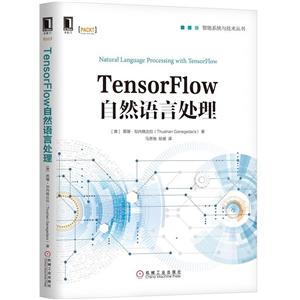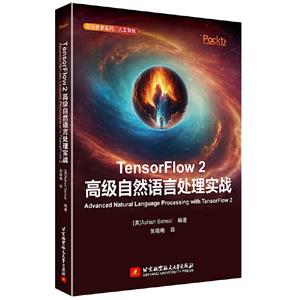
作者:ThushanGanegedara
页数:18,446页
出版社:东南大学出版社
出版日期:2019
ISBN:9787564182892
电子书格式:pdf/epub/txt
内容简介
自然语言处理(NLP)为深度学习应用程序提供了大部分可用的数据,而TensorFlow是目前可用的最重要的深度学习框架。《TensorFlow自然语言处理》将TensorFlow和NLP结合在一起,为你提供处理今天的数据流中大量非结构化数据的宝贵工具,并将这些工具应用到特定的NLP任务。
目录
Preface
Chapter 1: Introduction to Natural Language Processing
What is Natural Language Processing?
Tasks of Natural Language Processing
The traditional approach to Natural Language Processing
Understanding the traditional approach
Example – generating football game summaries
Drawbacks of the traditional approach
The deep learning approach to Natural Language Processing
History of deep learning
The current state of deep learning and NLP
Understanding a simple deep model – a Fully-Connected
Neural Network
The roadmap – beyond this chapter
Introduction to the technical tools
Description of the tools
Installing Python and scikit-learn
Installing Jupyter Notebook
Installing TensorFlow
Summary
Chapter 2: Understanding TensorFlow
What is TensorFlow?
Getting started with TensorFlow
TensorFlow client in detail
TensorFlow architecture – what happens when you execute the client?
Cafe Le TensorFlow – understanding TensorFlow with an analogy
Inputs, variables, outputs, and operations
Defining inputs in TensorFlow
Feeding data with Python code
Preloading and storing data as tensors
Building an input pipeline
Defining variables in TensorFlow
Defining TensorFlow outputs
Defining TensorFlow operations
Comparison operations
Mathematical operations
Scatter and gather operations
Neural network-related operations
Reusing variables with scoping
Implementing our first neural network
Preparing the data
Defining the TensorFlow graph
Running the neural network
Summary
Chapter 3: Word2vec – Learning Word Embeddings
What is a word representation or meaning?
Classical approaches to learning word representation
WordNet – using an external lexical knowledge base for
learning word representations
Tour of WordNet
Chapter 1: Introduction to Natural Language Processing
What is Natural Language Processing?
Tasks of Natural Language Processing
The traditional approach to Natural Language Processing
Understanding the traditional approach
Example – generating football game summaries
Drawbacks of the traditional approach
The deep learning approach to Natural Language Processing
History of deep learning
The current state of deep learning and NLP
Understanding a simple deep model – a Fully-Connected
Neural Network
The roadmap – beyond this chapter
Introduction to the technical tools
Description of the tools
Installing Python and scikit-learn
Installing Jupyter Notebook
Installing TensorFlow
Summary
Chapter 2: Understanding TensorFlow
What is TensorFlow?
Getting started with TensorFlow
TensorFlow client in detail
TensorFlow architecture – what happens when you execute the client?
Cafe Le TensorFlow – understanding TensorFlow with an analogy
Inputs, variables, outputs, and operations
Defining inputs in TensorFlow
Feeding data with Python code
Preloading and storing data as tensors
Building an input pipeline
Defining variables in TensorFlow
Defining TensorFlow outputs
Defining TensorFlow operations
Comparison operations
Mathematical operations
Scatter and gather operations
Neural network-related operations
Reusing variables with scoping
Implementing our first neural network
Preparing the data
Defining the TensorFlow graph
Running the neural network
Summary
Chapter 3: Word2vec – Learning Word Embeddings
What is a word representation or meaning?
Classical approaches to learning word representation
WordNet – using an external lexical knowledge base for
learning word representations
Tour of WordNet















